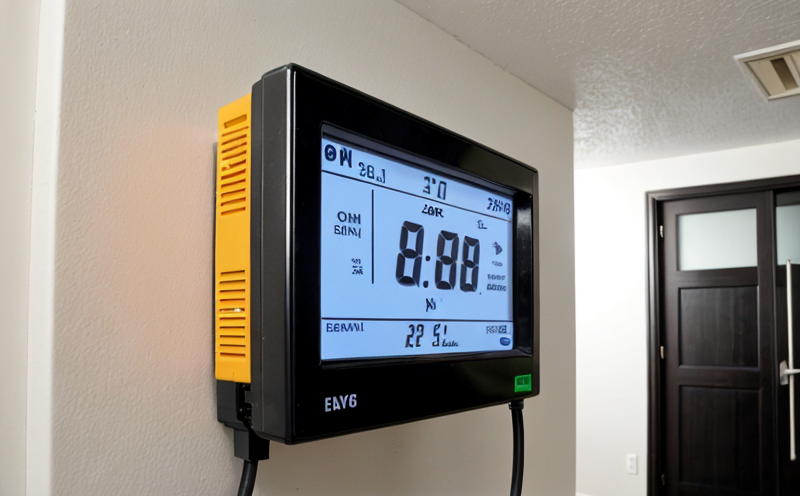IEC 62612 Energy Efficiency Testing of LED Lamps
The International Electrotechnical Commission (IEC) standard IEC 62612 is a crucial guideline for the energy efficiency testing of Light-Emitting Diode (LED) lamps. This standard provides comprehensive procedures to ensure that LED products meet stringent energy efficiency requirements, thereby contributing significantly to reducing global energy consumption.
IEC 62612 focuses on measuring the luminous flux and electrical power consumed by LED lamps under defined test conditions. The primary goal is to establish a reliable basis for comparing the energy efficiency of different LED products across various markets. This standard supports regulatory compliance, promotes sustainable technologies, and ensures consumer confidence in high-quality lighting solutions.
The testing process involves several key steps:
- Identification of the lamp model and relevant parameters,
- Setup of test fixtures to simulate real-world operating conditions,
- Measurement of luminous flux using photometric instruments,
- Determination of electrical power consumption through wattmeters.
The results are then compared against specified thresholds outlined in the standard. Compliance ensures that LED lamps meet global energy efficiency targets and can be marketed effectively within different jurisdictions.
Understanding these parameters is essential for quality managers, compliance officers, R&D engineers, and procurement specialists who must ensure their products comply with international standards like IEC 62612. This standard not only ensures product reliability but also supports broader sustainability goals by promoting efficient use of resources.
In summary, IEC 62612 plays a vital role in the development and certification of LED lamps, ensuring they meet stringent energy efficiency criteria. This process is critical for manufacturers aiming to enter global markets while maintaining high standards of quality and environmental responsibility.
Scope and Methodology
The scope of IEC 62612 covers the measurement of luminous flux and electrical power consumption for LED lamps. The standard provides a detailed methodology for conducting these tests, ensuring consistency and accuracy across different laboratories.
To conduct an accurate test according to IEC 62612, several steps must be followed:
- Selection of appropriate test fixtures that replicate the intended operating environment,
- Setup of photometric instruments for measuring luminous flux,
- Installation of wattmeters to measure electrical power consumption.
The testing procedure begins with selecting a representative sample of LED lamps. The lamps are then placed in the test fixtures and powered according to the standard's prescribed conditions. Photometric instruments are used to measure the emitted light, while wattmeters record the electrical power consumption.
After collecting data from multiple measurements, it is analyzed against the specified thresholds defined by IEC 62612. Compliance with these standards ensures that LED lamps meet global energy efficiency targets and can be marketed effectively within different jurisdictions.
The methodology outlined in IEC 62612 is designed to provide a reliable basis for comparing the energy efficiency of different LED products across various markets. This standard supports regulatory compliance, promotes sustainable technologies, and ensures consumer confidence in high-quality lighting solutions.
International Acceptance and Recognition
- The IEC 62612 standard is widely recognized globally for its stringent requirements on energy efficiency testing of LED lamps. It is accepted by many countries, including the United States, Canada, Europe, China, India, and Japan.
- Compliance with this standard ensures that LED products meet global energy efficiency targets and can be marketed effectively within different jurisdictions.
- The standard's acceptance is crucial for manufacturers aiming to enter international markets while maintaining high standards of quality and environmental responsibility.
Environmental and Sustainability Contributions
IEC 62612 plays a vital role in the development and certification of LED lamps, ensuring they meet stringent energy efficiency criteria. This process is critical for manufacturers aiming to enter global markets while maintaining high standards of quality and environmental responsibility.
The use of energy-efficient LED lamps contributes significantly to reducing greenhouse gas emissions by minimizing electricity consumption. By adhering to IEC 62612, manufacturers can help achieve broader sustainability goals by promoting efficient use of resources.
Compliance with these standards not only ensures product reliability but also supports global efforts towards sustainable development and energy conservation. The widespread adoption of LED lamps is expected to lead to substantial reductions in electricity demand, thus contributing positively to environmental protection.
In summary, IEC 62612 plays a crucial role in promoting sustainability through its stringent requirements on energy efficiency testing of LED lamps. This standard ensures that products meet global energy efficiency targets and can be marketed effectively within different jurisdictions.





